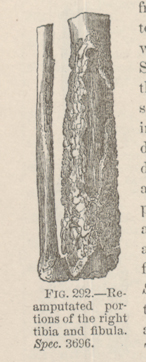Title: Grahame, F.
Source text: The Medical and Surgical History of the War of the Rebellion. (1861-65.), Part 3, Volume 2 (Washington, DC: Government Printing Office, 1883), 492.
Civil War Washington ID: med.d2e19401
TEI/XML: med.d2e19401.xml
CASE 743.—Private F. Grahame, Co. A, 6th Wisconsin, aged 26 years, was wounded at Spottsylvania, May 10, 1864. Surgeon C. N. Chamberlain, U. S. V., reported his admission to the field hospital of the 4th division, Fifth Corps, with "shot fracture of right ankle joint, followed by amputation of leg at lower third." The wounded man was conveyed to Armory Square Hospital, Washington, several days after the reception of the injury, and two months later he was transferred to Harvey Hospital at Madison, where, on September 7th, a second operation was performed by Surgeon H. Culbertson, U. S. V., who made the following report: "The stump of the tibia became necrosed from the lower end to its tuberosity. New bone formed, but the necrosed portion was not separating. There were several cloacæ, and the lower end of the tibia projected through the soft parts of the stump. The patient was in an anæmic condition and his system was failing from the constant discharge and reflex irritation from the diseased stump. Designing to resect the diseased tibia, I made an incision from the tuberosity of the bone down to its lower extremity, but on separating the soft parts I found the disease so extensive as to lead me to amputate by a short anterior and a long posterior flap at the tuberosity of the tibia. In notching the tibia the periosteum was pushed back, the notch sawed off, and the periosteum laid over the surface of the bone. The anterior and posterior tibial arteries were ligated. Simple dressings were applied after the operation, and quinine and iron was administered. The sutures were removed on the fifth day and the ligatures came away on the fourteenth day. The wound steadily healed." The re-amputated stump of the tibia and fibula (Spec. 3696, Surg. Sect., A. M. M.), the latter being well rounded and united at its extremity with the former, were contributed to the Museum by the operator, and are represented in the wood-cut (FIG. 292). The specimen shows a sequestrum in the tibia six inches long; over the upper part of the anterior border the involucrum is wanting. The patient was discharged from service August 22, 1865, and pensioned, having been previously furnished with a "Bly" artificial leg. In his application for commutation he described the stump as continuing in "healthy condition." This pensioner was paid March 4, 1880.
